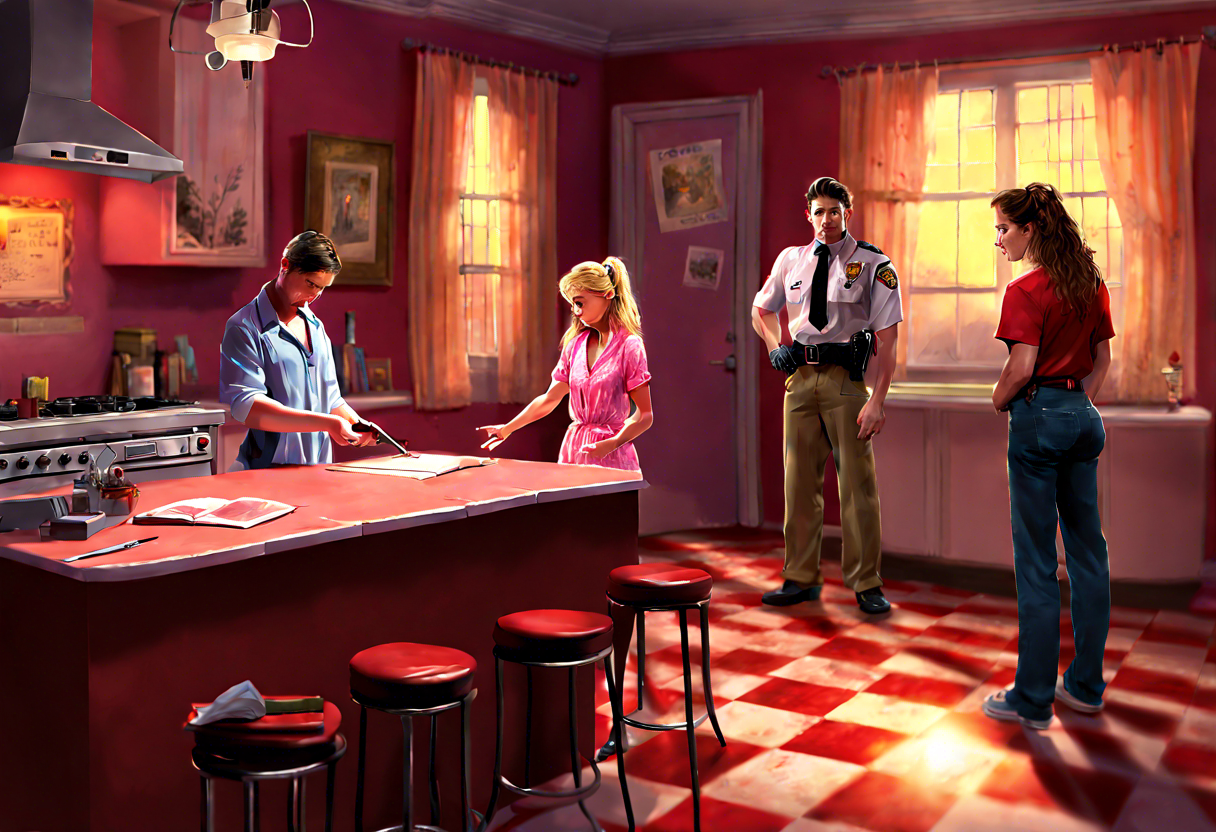Crimes of the Heart Play Book Review: An Overview
"Crimes of the Heart" by Beth Henley is a compelling play that delves into the intricacies of family dynamics and personal struggles. Set in Hazlehurst, Mississippi, the story follows the Magrath sisters – Lenny, Meg, and Babe – as they reunite at their family home after Babe shoots her husband. The play unfolds to reveal deep-seated family secrets, emotional turmoil, and moments of dark humor that make it a riveting piece of Southern gothic literature.
Henley’s narrative masterfully weaves together themes of love, loyalty, betrayal, and redemption against the backdrop of a dysfunctional yet endearing family. The characters are brilliantly nuanced, with each sister embodying a distinct personality that adds layers to the storyline. Lenny, the eldest sister, is portrayed as lonely and yearning for affection; Meg, the middle sister, is a failed singer with a complicated past; while Babe, the youngest, grapples with the consequences of her actions.
Throughout the play, the setting plays a crucial role in shaping the overall mood and atmosphere. The quaint Southern town of Hazlehurst serves as more than just a backdrop; it becomes almost a character in itself, influencing the actions and decisions of the sisters. The deep South setting adds a sense of nostalgia and melancholy to the story, enhancing the themes of tradition and family heritage that run throughout the narrative.
"Crimes of the Heart" has garnered critical acclaim for its poignant storytelling, well-drawn characters, and emotional depth. The play won the Pulitzer Prize for Drama in 1981, solidifying its status as a classic of American theatre. Audiences and critics alike have been captivated by the raw honesty and vulnerability of the characters, as well as the darkly comedic moments that provide relief amidst the underlying tension.
When comparing the play to its film adaptation, viewers often note the intimacy and immediacy of the live performance, which brings a unique energy to the story. While the film captures the essence of the play, there is a certain magic in experiencing the drama unfold on stage, where the raw emotions and conflicts of the characters are palpable in real-time.
In conclusion, "Crimes of the Heart" is a timeless masterpiece that continues to resonate with audiences decades after its debut. Henley’s exploration of family, love, and the complexities of human relationships makes this play a must-read for theater enthusiasts and anyone interested in the intricacies of the human heart.
Themes and Characters in Crimes of the Heart
Crimes of the Heart by Beth Henley is a Pulitzer Prize-winning play that delves into complex themes and intriguing characters. One of the prominent themes explored in the play is the notion of family dynamics and the intricate relationships between siblings. The Magrath sisters – Lenny, Meg, and Babe – are at the heart of the story, each dealing with their own struggles and conflicts. Through these characters, the play examines themes of resilience, redemption, and the enduring bond of sisterhood.
The character of Lenny is portrayed as the eldest sister who has shouldered the responsibilities of caring for their ailing grandfather and maintaining the family home. Her character embodies themes of loneliness and longing for love and companionship. Meg, the middle sister, grapples with shattered dreams and the consequences of her past actions. Her character symbolizes the pursuit of happiness and the complexities of personal identity. Babe, the youngest sister, finds herself entangled in a tumultuous relationship that leads to drastic consequences, highlighting themes of betrayal and forgiveness.
Another significant theme in Crimes of the Heart is the exploration of societal expectations and norms, particularly regarding gender roles and mental health. The play challenges traditional notions of femininity and explores the impact of societal pressures on individual lives. Through the characters’ interactions and struggles, Henley sheds light on the complexities of human emotions and the resilience of the human spirit in the face of adversities.
The setting of the play, a small town in the American South, serves as a backdrop that influences the characters’ decisions and actions. The Southern Gothic atmosphere adds depth to the storyline, evoking a sense of nostalgia and melancholy. The play skillfully intertwines the setting with the themes and characters, creating a rich tapestry of emotions and conflicts that resonate with the audience.
Crimes of the Heart is a compelling play that weaves together themes of family, resilience, and societal expectations through its well-crafted characters and captivating storyline. Henley’s exploration of the human experience and the complexities of relationships make this play a timeless classic that continues to resonate with audiences around the world.
Impact of the Setting on the Storyline
The setting in "Crimes of the Heart" by Beth Henley plays a crucial role in shaping the storyline and the characters’ dynamics. The entire play is set in Hazlehurst, Mississippi, in the 1970s. The Southern Gothic setting with its hot and humid climate, sprawling plantation houses, and conservative social norms creates a unique backdrop for the unfolding drama. The decaying Magrath family home where the three sisters reunite after a tragic event mirrors the crumbling state of the family itself. The setting emphasizes the isolation and claustrophobia experienced by the characters, intensifying their internal struggles and conflicts.
Moreover, the Southern setting is not merely a physical backdrop but also serves as a thematic element in the play. The societal expectations and traditions specific to the Southern culture influence the characters’ behaviors and choices. The Southern Gothic elements such as family secrets, eccentric relatives, and a sense of foreboding contribute to the overall atmosphere of the play. The dilapidated kitchen, where much of the action takes place, becomes a symbol of the family’s history, struggles, and unresolved issues.
Additionally, the rural Southern setting enhances the themes of love, sacrifice, and redemption explored in the play. The sense of nostalgia and longing for the past prevalent in Southern literature is evident in "Crimes of the Heart." The characters’ deep connection to their hometown and its quirks influences their decisions and relationships. The setting’s slow pace and the characters’ drawling Southern accents create a laid-back atmosphere that contrasts with the intense emotional drama unfolding on stage.
The setting in "Crimes of the Heart" is not merely a backdrop but a character in itself, shaping the storyline, themes, and character development. The Southern setting adds depth and richness to the play, immersing the audience in a world where family ties are strong, secrets run deep, and redemption is possible amidst tragedy. Henley’s skillful use of setting highlights the interconnectedness of people and place, making "Crimes of the Heart" a compelling exploration of the human experience in a specific cultural context.
Critical Reception of Crimes of the Heart
Crimes of the Heart, written by Beth Henley, has garnered both critical acclaim and audience appreciation since its debut in 1979. The play follows the three MaGrath sisters, Meg, Babe, and Lenny, who reunite at their family home in Mississippi to face the consequences of their troubled pasts and confront dark secrets. The compelling storyline and well-rounded characters have captivated theater enthusiasts for decades.
Critics have lauded Crimes of the Heart for its deep exploration of familial relationships, resilience in the face of adversity, and dark humor that is woven throughout the narrative. The play won the Pulitzer Prize for Drama in 1981, solidifying its reputation as a timeless classic in American theater. Audiences have been drawn to the authenticity of the characters and the raw emotions depicted on stage, making it a favorite for theater companies to perform across the globe.
The play’s ability to seamlessly blend moments of heart-wrenching drama with comedic elements has been praised for its nuanced portrayal of the complexities of human nature. The themes of forgiveness, redemption, and the enduring bonds of family resonate with viewers of all backgrounds, leading to numerous successful revivals and adaptations over the years.
Crimes of the Heart’s enduring popularity is a testament to its universal themes and expertly crafted storytelling. Its ability to navigate the darker aspects of life with wit and warmth has cemented its status as a beloved piece of American theater that continues to captivate audiences and critics alike.
Comparing the Play to the Film Adaptation
Comparing Crimes of the Heart Play to the Film Adaptation
When comparing the play "Crimes of the Heart" to its film adaptation, directed by Bruce Beresford and released in 1986, there are both similarities and differences that stand out. One of the most apparent distinctions is the way in which each medium presents the storyline. The play, written by Beth Henley, delves deep into the complexities of sisterhood and family bonds through dialogue and stage direction, allowing the audience to engage with the characters in a more intimate setting. On the other hand, the film adaptation brings a visual element to the story, offering a more cinematic experience with its use of settings, camera angles, and music to evoke emotions from the viewers.
In terms of character portrayal, both the play and the film capture the essence of the Magrath sisters—Lenny, Meg, and Babe—and their individual struggles effectively. However, due to the differences in the storytelling mediums, certain nuances in the characters’ development may stand out more prominently in one version over the other. For example, the play may allow for more in-depth exploration of the sisters’ internal conflicts through monologues and interactions, whereas the film adaptation can use visual cues and facial expressions to convey emotions in a more nuanced way.
Another aspect to consider when comparing the play to the film adaptation is the impact of the setting on the overall narrative. The play’s confined setting of the Magrath family home in Mississippi creates a sense of claustrophobia and intensifies the emotional dynamics between the characters. In contrast, the film adaptation has the advantage of utilizing different locations and visual elements to enhance the storytelling, providing a broader scope for the audience to immerse themselves in the world of the Magrath sisters.
While both the play "Crimes of the Heart" and its film adaptation offer unique insights into the complexities of familial relationships and personal struggles, each medium brings its own strengths to the table. Whether experiencing the story on stage or on screen, audiences are sure to be captivated by the timeless themes and compelling characters that make "Crimes of the Heart" a beloved classic in both theater and film.
Key Takeaway:
"Crimes of the Heart" is a powerful play that delves into the complexities of familial relationships and the struggles of three sisters in a small Mississippi town. The themes of love, resilience, and the consequences of the past are intricately woven throughout the storyline, bringing to life characters that are both flawed and endearing. The setting of the play plays a crucial role in driving the narrative forward, evoking a sense of nostalgia and Southern charm that adds depth to the characters’ experiences.
The critical reception of "Crimes of the Heart" has been overwhelmingly positive, with praise for its emotional depth, authentic dialogue, and compelling performances. The play has been lauded for its ability to balance moments of dark humor with poignant reflections on the human condition. When comparing the play to the film adaptation, it is evident that both mediums capture the essence of the story effectively, though each offers a unique perspective on the sisters’ journey towards self-discovery and healing.
In conclusion, "Crimes of the Heart" is a timeless exploration of family dynamics and personal redemption that continues to resonate with audiences today. Through its rich themes, well-developed characters, and captivating setting, the play remains a celebrated piece of literature that reminds us of the enduring power of love and the strength found in the bonds of sisterhood.
Conclusion
In conclusion, "Crimes of the Heart" by Beth Henley is a timeless play that delves into the complexities of family relationships, the struggles of the human heart, and the resilience of the human spirit in the face of adversity. The play weaves together themes of forgiveness, redemption, and the power of familial bonds, making it a captivating and emotionally rich piece of literature.
The characters in "Crimes of the Heart" are intricately crafted, each with their own flaws, desires, and vulnerabilities. Lenny, Meg, and Babe Magrath are brought to life on the stage with their unique personalities and heartbreaking pasts, drawing the audience into their world and evoking a range of emotions from laughter to tears.
The setting of the play, a small town in Mississippi, plays a crucial role in shaping the storyline and the characters’ lives. The Southern atmosphere, complete with its traditions, quirks, and deep-rooted family ties, adds depth and authenticity to the narrative, transporting the audience to a world where secrets are buried deep but eventually come to light.
"Crimes of the Heart" has received critical acclaim since its debut, with praise for its sharp dialogue, authentic portrayal of sisterhood, and raw emotional power. The play’s ability to balance humor and tragedy, lightness and darkness, has resonated with audiences and critics alike, solidifying its status as a modern classic in American theater.
When comparing the play to the film adaptation, one can see how the essence of the story and characters remain intact while being reimagined for the big screen. While both versions have their strengths, the play offers a more intimate and immersive experience, allowing the audience to connect with the characters on a deeper level and truly feel the emotional impact of their journey.
Overall, "Crimes of the Heart" is a compelling and thought-provoking piece of literature that continues to captivate audiences with its powerful storytelling, memorable characters, and timeless themes. It is a testament to the enduring power of family, love, and forgiveness, making it a must-see for theater enthusiasts and literature lovers alike.



